|
What is a nerve? |
|
A bundle of hundreds to thousands of axons, C.T and blood vessels that lies outside the braind and spinal cord. |
| |
|
Spinal Cord |
|
Contains 31 pairs of spinal nerves |
| |
|
Ganglia |
|
"Swelling or knot"
Small masses of nervous tissue, mostly body cells of neurons, outside the brain and spinal cord.
Associated with cranial, spinal nerves.
|
| |
|
`Enteris plexuses |
|
The extensive networks of neurons in walls of organs and GI tract. |
| |
|
Sensory receptors |
|
Dendrites of sensory neurons, or separate, specialized cells that monitor chainges in internal, external environments.
Photoreceptors in retina of eye.
|
| |
|
Functions of nervous system |
|
Carries out complex tasks: sensing smells, producing speech, providing signals that control body movments, etc. |
| |
|
Sensory function |
|
Sensory receptors that detect internal stimuli:
Inc. in blood acidity
External: raindrop landing on arm.
|
| |
|
Sensory (Afferent) neurons |
|
Carry information from lower level to higher level in spinal cord and brain. |
| |
|
Integrative function |
|
Intergrates (processes) sensory information by analyzing and storing some of it and making decisions. |
| |
|
Interneurons |
|
Many neurons that participate in integration.
The axons extend only for a short distance, contact nearby neurons in brain, spinal cord or ganglion.
|
| |
|
Motor function |
|
Responding to integration decisions. |
| |
|
Effectors |
|
Cells and organs contacted by motor neurons in cranial and spinal nerves. |
| |
|
Central nervous system (CNS) |
|
Brain and spinal cord: Thoughts, memories and emotions. |
| |
|
Peripheral nervous system (PNS) |
|
All nerves, except brain and spinal cord. Include cranial, spinal nerves, their branches, ganglia and sensory receptors. |
| |
|
Axillary nerve |
|
Supplies the deltoid and teres minor muscles. |
| |
|
Ipsilateral |
|
on or relating to the same side (of the body) |
| |
|
Transverse |
|
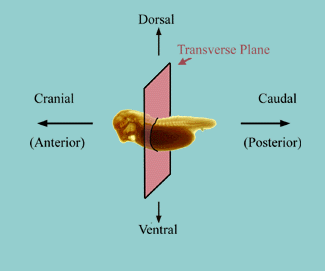
Down middle |
| |
|
Epigastric region |
|
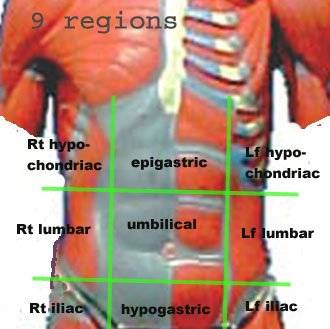
Top middle |
| |
|
Hypogastric region |
|
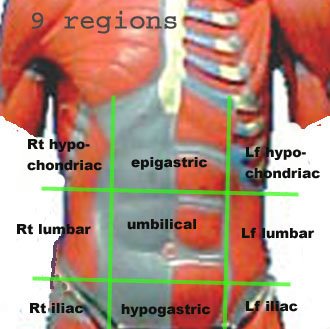
lower middle |
| |
|
illiac region |
|
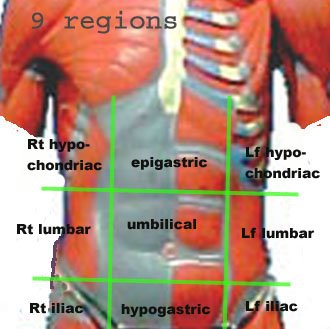
lower left/right side of nines |
| |
|
Lumbar region |
|
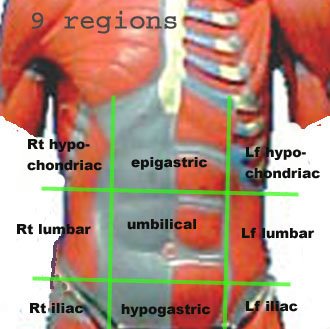
middle left/right side of nines |
| |
|
Anatomincal position |
|
Standing erect, with feet and palms facing forward. |
| |
|
Polyunsaturated fats |
|
contain more than 1 dbl covalent bond between fatty acid carbon atoms.
e.g: canola, linoleic, corn, safflower and soybean oil.
|
| |
|
tRNA |
|
Transfer RNA - carries amino acids into ribosomes and bonds with mRNA for protein production. |
| |
|
Integral protein |
|
Permanently attached to the biological membrane. |
| |
|
Selective permeability |
|
will allow certain molecules or ions in via diffusion or facilitated diffusion. |
| |
|
Active transport |
|
Based on size
Requires ATP
Goes against concentration gradient
|
| |
|
Hypertonic solution |
|
"greater than"
Higher concentration of solutes.
|
| |
|
Cytoskeleton |
|
Structure: proteins, microfilaments (actin), intermediate filaments (keratin), microtubles.
Functions: support, transport (secratory granules, organelles)
|
| |
|
Mitochondria |
|
Cellular respiration
ATP production
Self replicatin
|
| |
|
Ribosomes |
|
Structure: RNA, protein, lg subunit, sm subunit
Function: mRNA & tRNA, protein synthesis
|
| |
|
Centrosome |
|
Involved in cell division (mitosis/meiosis) |
| |
|
Cilia and Flagella |
|
Aid in cell movement |
| |
|
Smooth endoplasmic reticulum (SER) |
|
Structure: NO RIBOSOMES, dbl membrane
Function: synthesis of non-proteins, transport, storage
|
| |
|
Rough endoplasmic reticulum (RER) |
|
Structure: dbl membrane, phospholipids/proteins, ribosomes
Function: site of protein synth, transport, temp storage
|
| |
|
Golgi Apparatus |
|
Structure: phospholipids, proteins
Function: packaging, concentrating, assembly, etc of cell products.
|
| |
|
Lysosome |
|
Structure: H+ ion pumps, enzymes
Function: digestion, worn out membranes, worn out organelles, microorganisms, autophagy, heterophagy
|
| |
|
Microvilli |
|
Structure: actin
Function: increases surface area
|
| |
|
Nucleus |
|
Structure: nuclear envelope, nucleoli, chromatin
Function: controls protein synthesis, Cell division (mitosis/meiosis)
|
| |
|
Plasma membrane |
|
Structure: phospholipid bilayer, cholesteral, protein, carb
Function: Separation, transport, reception, recognition, enzyme location
|
| |
|
Epithelial tissue |
|
Line the cavities and surfaces of structures. Most glands are formed from epitheliul tissue. |
| |
|
Serous membrane |
|
A smooth membrane consisting of a thin layer of cells which excrete serous fluid. |
| |
|
Hyaline cartilage |
|
A cartilage with a homogeneous matrix. It is the most common type, occurring at the articular ends of bones. |
| |
|
Collagen fibers |
|
"colla = glue"
Very strong, resists pulling forces, but not stiff. Promotes tissue flexibility.
|
| |
|
Exocrine glands |
|
Glands that secrete their products into a duct.
|
| |
|
Lacuna |
|
Small space containing an osteocyte in bone or chondrocyte in cartilage. |
| |
|
Stratum basale |
|
The deepest epidermal layer, where mitotic activity occurs. |
| |
|
Layers of skin |
|
stratum corneum- stratum licidum
- stratum granulosum
- stratum spinosum
- stratum basale
|
| |
|
keratin |
|
Tough and insoluble.
Hair and nails are made of keratin
|
| |
|
Pacinian corpuscles |
|
Sensitivity to deep pressure touch. |
| |
|
Cuticle |
|
Dead layers of epidemal cells or keratinocytes |
| |
|
Acne |
|
Inflammation of sebacious glands |
| |
|
Types of burns |
|
1st degree - damage to epidermis
2nd degree - damage to epidermis and dermis
3rd degree - damage to epidermis, dermis and hypodermis
|
| |
